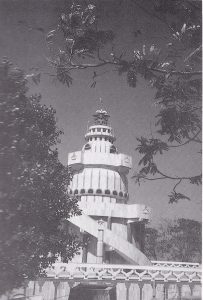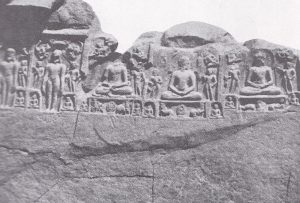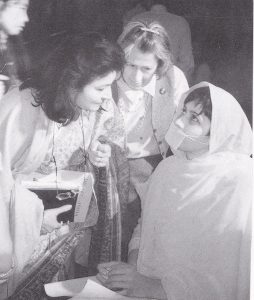Rajgir
If some day the world’s leading advocates of animal rights should require a suitable site for a monument to commemorate the beginning of what by now has become a world-wide concern of millions of people – the protection of all that lives – Rajgir, anciently Rajagriha, in Bihar would be the place to choose.
In Sister Nivedita’s” Footfalls of Indian History (Calcutta, 2nd reprint 1980: 149/51). we read: “We know the age of a heresy by the tenets it contradicts, and in repudiating the authority of the Vedas. Jainism proves itself the oldest form of non-conformity in India.
Only by accepting the Jaina tradition, moreover, as to the influence which their Gurus had upon the Buddha, are we able to account satisfactorily for the road taken by Him [the Buddha] from Kapilavastu to Bodh Gaya through Rajgir. He made his way first of all to the region of the famous Jaina teachers.
If, again, there should be any shred of truth in Sir Edwin Arnold’s story (presumably from the Lalita-Vistara) that it was at Rajgir that He interceded for the goats, the incident would seem under the circumstances the more natural. He passed through the city on His way to some solitude where He could find realisation, with His heart full of that pity for animals and that shrinking from the thought of sacrifice, which was the characteristic thought of the age, one of the great preoccupations, it may be, of the Jaina circles He had just left.
And with His heart thus full, He met the sacrificial herd, marched with them to the portals of Bimbisara’s palace, and pleaded with the king for their lives, offering His own in their place.” Whether this was actually so or not, it is certain that one of the great impulses of the day lay in the rebellion against the necessity of the Vedic sacrifice; one of its finest sincerities, in that exalta- tion of the personal experience which made it seem natural to found on it a religion.
That a man’s religious conviction must be the result of his own private realisation of truth is an idea so old in India as to lie beyond the Upanishads themselves. But that such a realisation had a right to be socialised, to be made the basis of a religious sect. is a principle which was first perhaps grasped by the Jainas.
The religious teacher of those days lived retired in the forest clearings and gathered round him, not a sect. but a school, in the form of a few disciples. Jainism, with its sudden intense revolt against the sacrificial idea, and its sudden determination to make its pity effective for the protection of dumb animals, was the first religious doctrine to call social forces to the aid in India, in other words, it was the first organised sect or church.”
Sister Nivedita was born in Ireland in 1867 as Margaret Elizabeth Noble but the latter punt of her life she spent in India as a follower of Ramakrishna and a teacher, mostly in Calcutta. She died at Darjeeling in 1911.
Bimbisara and his som Ajatasatru appear in Jama texts as Shrenika and Kunika ar Kuniya respectively. See also ill. 263.
 Map of Rajgir. Reprint from a recommendable publication entitled RAJGIR, published by and available from the Archaeological Survey of India, Patna Circle, Patna. The added layout of the Jaina Veerayatan Ashram is not to scale. (Courtesy the Archaeological Survey of India.)
Map of Rajgir. Reprint from a recommendable publication entitled RAJGIR, published by and available from the Archaeological Survey of India, Patna Circle, Patna. The added layout of the Jaina Veerayatan Ashram is not to scale. (Courtesy the Archaeological Survey of India.)
Raigir. A modern Digambara temple on top of Vipula Hill.
Outline of a seated Jina on the inner rear wall of the eastert Sonbhandar Cave, excavated in the southern scarp of the Vaibhara Hill Third or fourth century AD. The roof of this part of the cave has collapsed but is still intact in the western half of the cave.
 Defaced Jina images on the inner wall of the easter Sonbhandar Cave. (Courtesy Archaeological Survey of India.)
Defaced Jina images on the inner wall of the easter Sonbhandar Cave. (Courtesy Archaeological Survey of India.)
The Chinese traveller Hiuen Tsang who visited Bihar in the seventh century described Rajgir as a prosperous city. At that time, the Jainas apparently occupied one half of the city, the Buddhists the other. In modern times, the ruins of an ancient Adinatha temple were discovered on top of Vaibhara Hill and partly restored.
Some of the niches surrounding the central chamber of this temple contain images of Tirthankaras, important finds for students of Jaina art. The inscriptions date back to the fifth and eighth century. The other Jaina shrines nearby, one large and some small ones, are modern structures, as are the temples on the four other hills.
In recent times. Rajgir’s appeal to Jaina pilgrims and travellers received an additional attraction – the Veerayatan Ashram whose large campus extends out into virgin land at the eastern foothills of Vaibhara Hill. The inspiration for this chari- table venture came from the late Sthanakavasi Muni Gurudev Amar. That it became a reality within a few years was due to the devoted determination of Sadhvi Acharya Chandana and her small group of nuns (see pages 216/17).
Besides the Eye Hospital, the ‘temple of worship’ in this unique ashram, there is a permanent three-dimensional exhibition depicting the life of Mahavira, which by now has been seen by more than half a million visitors. Rajgir was a favourite place of sojourn for Mahavira who is known to have spent as many as fourteen rainy sea- sons in this ancient city. Munisuvrata, the twentieth Tirthankara, was a native of Rajgir.
Mahavira who is known to have spent as many as fourteen rainy sea- sons in this ancient city. Munisuvrata, the twentieth Tirthankara, was a native of Rajgir.
Sadhvi Shilapi, the first Jaina nun ever to study at a western university (namely Comparative Religion at King’s College, London), joined the Veerayatan Ashram in 1986 and took diksha in 1991. This photo was taken at the opening of the exhibition The Peaceful Liberators Jain Art from India at the Victoria and Albert Museum, London, November 1995.
